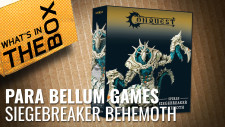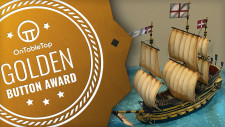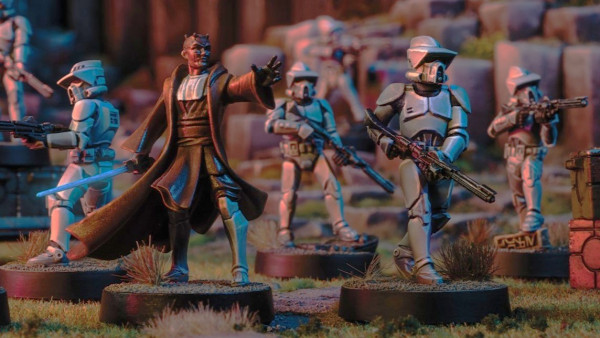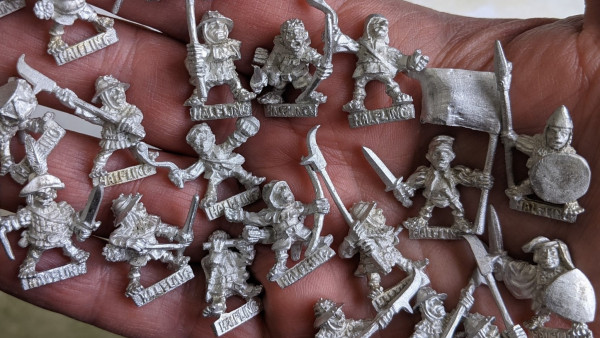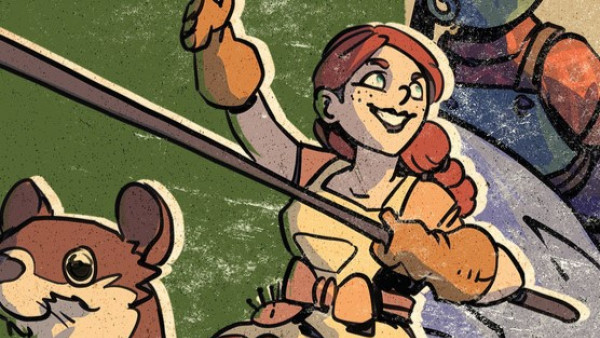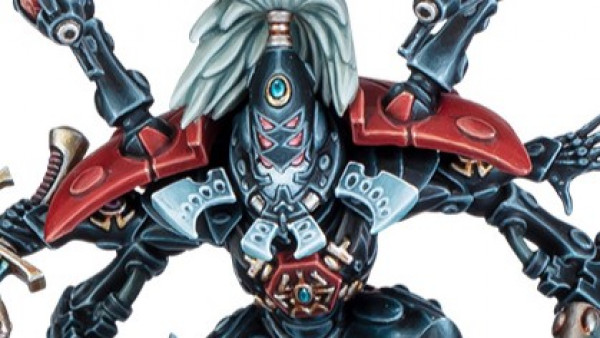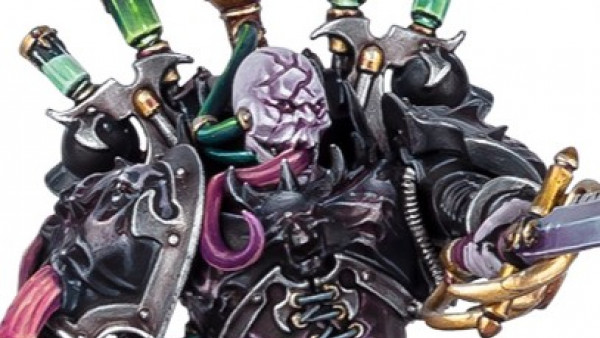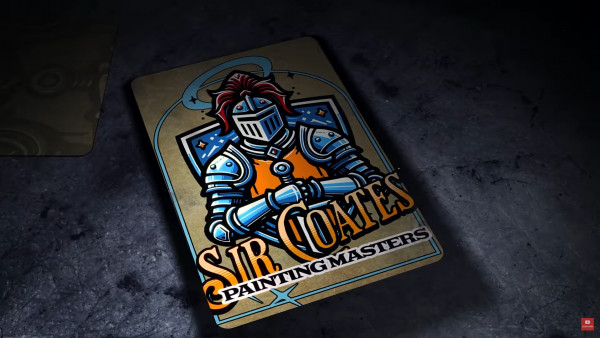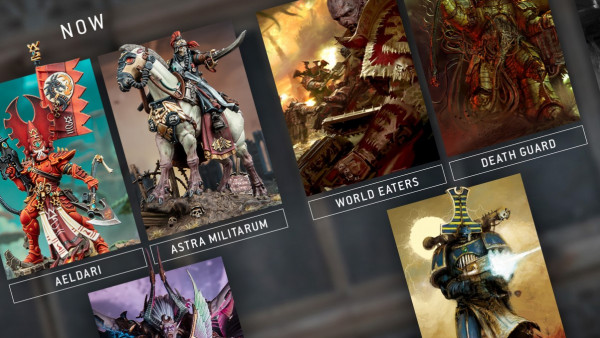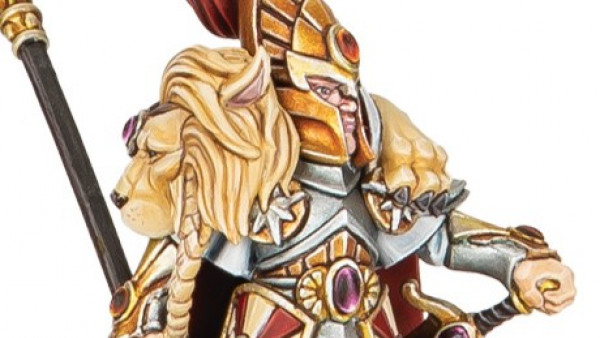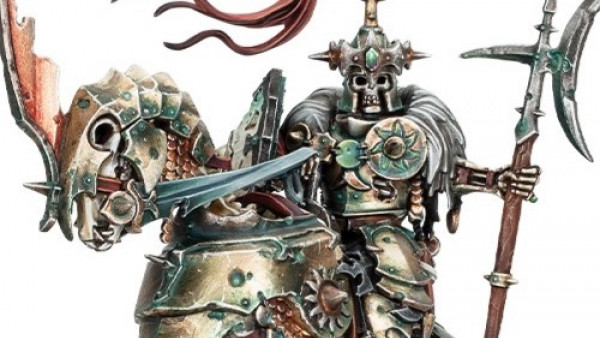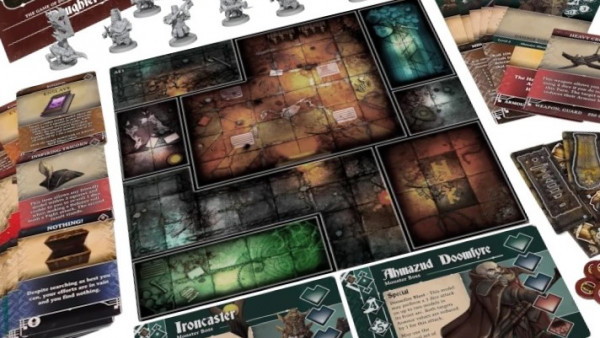Home › Forums › Historical Tabletop Game Discussions › Poland 1939 – Preparing for 80th Anniversary of World War II
Tagged: historical, Oriskany, Poland, World War II, Yavasa
This topic contains 121 replies, has 12 voices, and was last updated by jamesevans140 5 years, 4 months ago.
-
AuthorPosts
-
August 15, 2019 at 8:03 pm #1426751
So the Strategy and Tactics article focuses on the 1st Battle where the Polish forces tried to breakthrough the encirclement. While retreating towards Warsaw and/or Lwów both armies “Kraków” and “Lublin” due to the presence of the Warsaw Armoured Motorized Brigade decided that the march needs to be continued along paved roads. This led to Tomaszów Lubelski which sadly was already in German hands. Polish forces divided into two groups. The first one attacked on the line Zielone – Rogoźno and it compromised of the 1 Pułk Strzelców Konnych (1st Mounted Rifles Regiment – don’t know if it’s the correct name in English yet) with the help of Vickers and TKS tanks company. The second one attacked through Łasochy and Pasieki and was made of 1st Rifles Regriment backed by a the armored group led by Stanisław Majewski (11th Armoured Detachment, 33 Armoured Detachment, 2nd Light Tanks Batalion – used 7tp Tanks and 62nd Recon Tanks Company – used TKS “tanks”) All in all the Warsaw Armoured Motorized Brigade had more or less 22 7TP tanks and 14 Vickers Tanks. While the Zielone – Rogoźno attack did not succeed. The Łasochy – Pasieki one was a success with the attackers clearing most of Tomaszów Lubelski but the overwhelming German forces managed to counter attack with the use of the 2nd Panzer Division. So the Poles had to withdraw. They took another attempt at taking the city but it did not succeed. That’s in a REAL nutshell.
August 15, 2019 at 8:15 pm #1426759The Battle of Mokra is one of more interesting battles in Poland as it forced the withdrawal of the 4th Panzer division, had armoured trains involved and was the battle that led to the myth of Polish Cavalry charging German tanks
August 15, 2019 at 8:23 pm #1426760The first few chapters of Jan Karski – Story of a Secret State talk about the initiation of war from his view point and generally an interesting read!
August 15, 2019 at 8:25 pm #1426762
@yavasa – the article is by Maciej Jonasz, and covers a lot more than that little blurb I just dropped in there earlier. 😀 In summary, we’re looking at the merging of remnants of Krakow and Lublin armies, which were trying to head southeast toward Romania where shipments of Allied arms were expected. German XXII Corps had already partially reached Tomaszow, more or less behind these units. even as they were being pressed by four German infantry divisions from the front (8th and 28th of VIII Corps and 27th and 68th of VII Corps), putting this group of Polish forces in a semi-pocket. Engagements covered range from 16 to 20 September.
We’re definitely looking at the same two battles.
I say German XXII Corps had partially reached Tomaszow because the 4th Light Division was there, and as you say pretty badly hammered by the Warsaw Brigade, the “Sandomierz Group” and the “Krakowska Cavalry Group.” I’m not 100% sure yet what was in these groups because I’m still sifting through research and I’m getting the feeling these are collections of remnants (campaign was well into its third week by this point). But yes, whatever progress was made by the Poles at Tomaszow against 4th Light (33rd Panzer Abtg, 9th Aufskg Bn, 10 & 11th Schutzen, 86th Pioniere, 50th PzAbwehr Abtg, etc) would be largely negated by the 2nd Panzer when it arrived a few days later (a full Panzer division, unlike 4th Light).

The quality of these maps is admittedly terrible, I’m working with PowerPoint and the office scanner here. When I get home I’ll try to work up better materials.
August 15, 2019 at 9:22 pm #1426775@oriskany the Sandomierz Group consisted of two not full reserve regiments of infantry and a battalion of artillery.
It consisted on the 94th and 164th regiments of infantry. The 94th regiment had the 63th anti tank company from the 12 Infantry Division and the 164th had the 36th anti tank company from the 36 Infantry Division. At the time of our interest the group also included the 6th battery of the 55 Regiment of Light Artillery (3x 75mm guns) and the 9th battery of the 55 Regiment of Light Artillery (don’t know how many guns but I assume that also 3). From 15th of September you can add a company of bicycles from the 7th Infantry Division. 101st Company of anti aircraft heavy mgs.
August 16, 2019 at 3:45 pm #1427059Today, a sentimental trip. Maybe it does not reach as far as Panzer Leader since we’re just moving back to 1992 but here are some pictures of Bzura 1939 game by Dragon. As you will see my copy has been used heavily and is not in looking too good.
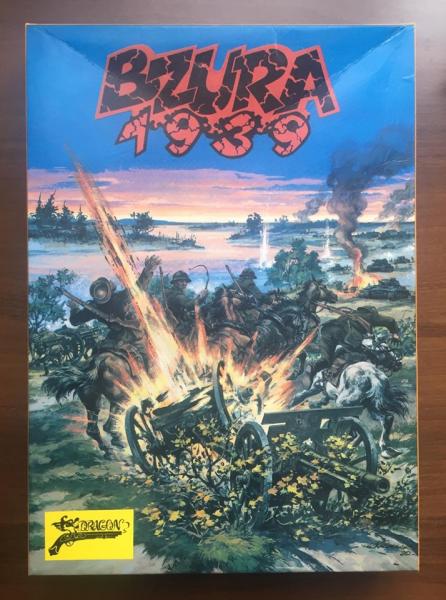 The box.
The box. Part of the map with battle results tables.
Part of the map with battle results tables.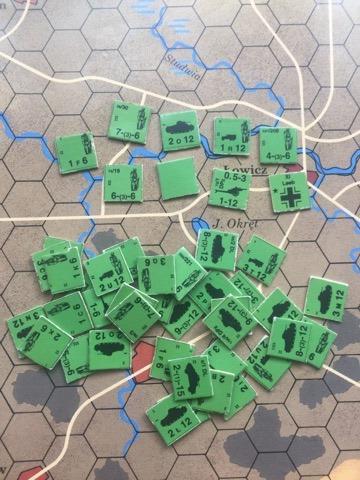 German counters. Green not grey… weird.
German counters. Green not grey… weird.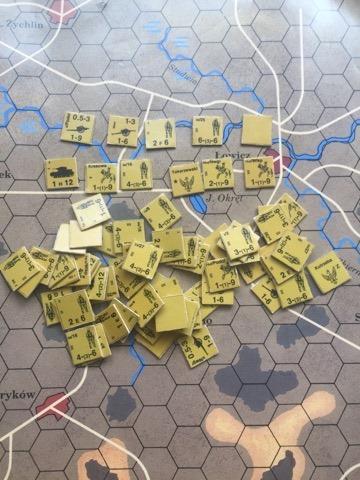 Polish counters.
Polish counters.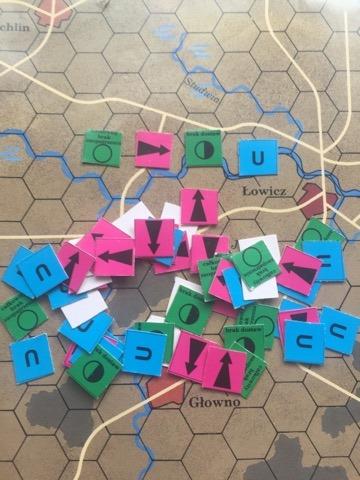 Auxiliary counters like retreat, lack of supply etc.
Auxiliary counters like retreat, lack of supply etc.The game itself focuses on the biggest battle of the September Campaign fought between 9-18th of September. It’s an operational level game which uses regiments and battalions mostly but for example cavalry units are represented as brigades due to the earlier loses. Retreating towards Polish armies “Poznań” and “Pomorze” fought against German 8th and 10th Armies. It was a major Polish counterattack that despite being in the unsuccessful forced Germans to change their plans, slowed their advanced in the Lublin area and allowed the defense of Warsaw to hold on for a longer period of time.
August 16, 2019 at 4:08 pm #1427066Thanks for the great reply @oriskany.
You can also add to the mix the experience gained by the Condor Legion in Spain.
However the Pole are tough fighters for the motherland. Far tougher than documentaries give them credit for. Just like the Finns they did not have the equipment but made up for it by holding their ground making the enemy get up and personal where advantages of better support equipment is somewhat neutralized, similar to the “grab them by their belts” tactics used later on by the Russians.
However don’t get me wrong here as I am not saying the Poles were just having a bad day as it was not going to go their way. Trying to strongly defend the boarders instead of a defence in depth plays into Blitzkrieg hands. The point I raised is that it was not the push over history now tells us and I am sure you agree. In the computer hex games playing the German most of my losses were infantry vs infantry battles.
I gained my appreciation to the Polish tankette when I motorised some companies of Grenadiers in our Finnish campaigns with them along with the Bren Gun Carriers. In one I deployed them in the waistline of Finland. In this area the BTs and T-26s tend to behave more like beached whales. I just wish I could have more of them. While the Carriers and Tankettes are similar in what they can do to infantry the tankettes are fully enclosed making them more durable.
As far as armoured ranges are concerned, physically the later weapons can open up the ranges, but at this early point of the war most armoured units are still to learn to make proper use of terrain on the approach and as such range opens up a bit. The Finns hold the record for maximum range of a kill by 20mm and 37mm AT shots, both times the victim was the T-26 with the range at nearly 2kms. I am the first to say this is extreme and not the norm. On the otherhand 500-800m is not unreasonable which is a similar engagement range in NW Europe later in the war. If tactics were better at this point in the war you could more than halve range to 250-400m.
So I am very interested how you and @yavasa turn out in this series. I am too busy at the moment to look at this on the tabletop but I am lucky that the guys have given me time off to read these articles. 🙁
August 16, 2019 at 4:35 pm #1427069Thanks for your reply @yavasa. I have seen the full length version of the mock battle by the German propaganda machine, but I have not seen anything the Russian propaganda machine produced. In the German one you seen the smoke coming out of the tank Mgs firing blanks and yet directly in front of it there are guys standing up in the saddle straining to see where the camera is and is not in the slightest worrying about the blazing tank coming at him.
Let’s face it the first rule of warfare is that you only attack if you can be the schoolyard bully. How can horses bully tanks? I know that when most people think of cavalry in Ww2 they think of them as Napoleonic cavalry. If using Napoleonic terms WW2 cavalry are more properly Dragoons. But I know what you are saying, a number of my family were Australian Light Horsemen and even then the horses were meant to be transport even though they are credited as delivering the last and greatest cavalry charges, however I think the historians are totally ignoring the Russian Cossacks of WW2. Here again they were meant to use their horses for movement.
Looking forward to see more from you and @oriskany on this topic. I like the early war period. I have an early war German army and play against British forces. I have hoped that someone in our group decides to build a Polish force.
August 16, 2019 at 7:34 pm #1427127
@yavasa –
I can confirm your composition of the Sandomierz Group . As shown in the OOB chart below, I’m seeing the 94th and 164th Infantry Regiments, reinforced by elements of what looks like a battalion-sized group of survivors from 15th Regiment and 2nd Battalion / 54th Regiment. I also see two batteries of AT guns (these might be the 63/12th ATC and 36/36 ATC you mention), a platoon of miscellaneous artillery, and 2nd Battalion / 55th Artillery Regiment (as you mention, 6th nd 9th batteries might be formed into the 2nd Battalion me records show). I’m also showing a stack of AA units along the bottom of the Sandomeirz Group, looks like five AA batteries of various types plus two more batteries of MG AA guns (probably including the 101st you mention, your records seem to be more detailed than mine).
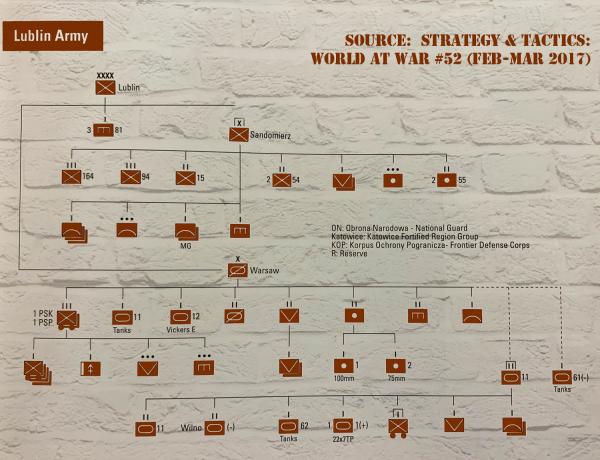
So for Saturday’s game, I’m looking at the Warsaw Armored Motorized Group, and its attack against 4th Light Division along the northwestern outskirts of Tomaszow.
So here’s the larger area map (open image in new tab for best resolution).

Zooming in, we see the Warzaw Armored Motorized Group making its final attacks southeast toward Tomaszow.
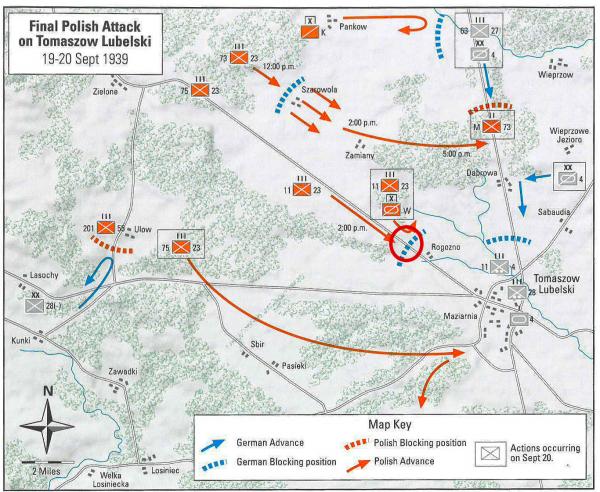
This is the map I drew last night on the Sitrep Twitch Stream (that western village will be Rogozno. You can see the general northwest-southeast run of the Tomoszow road, as well as the three-forked stream indicated above.
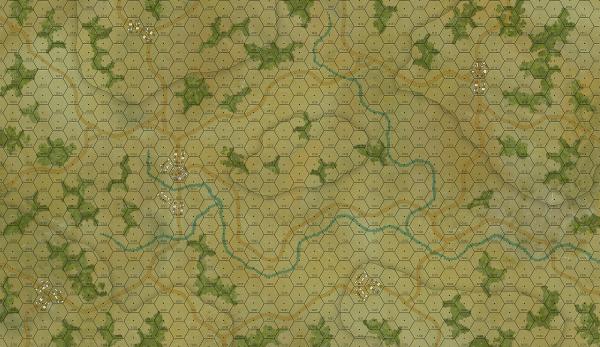
Polish composition will be based on the Warsaw Armored Motorized group described on the OOB Chart above.
More to come later. Someone just pulled the fire alarm in our office building! 😀 😀 😀
August 16, 2019 at 8:17 pm #1427133@oriskany +1 on the research 😉
The 2nd battalion of the 54 regiment of infantry from the 12 Infantry Division joined Sandomierz Group on the 7th of September. There is a problem with the AA units since the 2 batteries of 4x 4omm Bofors guns were present in the group only untile the 14th of September. We’re talking here about the 6th Anti aircraft Battery and 22nd Motorowa Anti aircraft Battery. The 102nd Independent Company of Anti aircraft Heavy Mg’s was present in the group until 10th of September. So in fact the AA support was consisting of:
- 2nd Battery of the 1st Independent Battalion of Artillery 2x 75mm guns
- Mościce platoon of 40mm AA guns
- 101st Independent Company of Anti aircraft Heavy Mg’s
Plus the group had a company of engineers.
What is more on the night of 14/15 September the group marched over 40km through burning woods and German fire ambushes from the Annopol-Oblęcin area. It reached Modliborzyce at 8AM to loosen the Recon battalion from the Warsaw Armored Motorized Brigade. Soon before reaching Modliborzyce a heavy air strike broke and dispersed the following units:
- 2nd battalion of the 94th regiment
- 2nd battalion of the 54th regiment
- 1st battalion of the 164th regiment
This reduced the group to six battalions when it comes to infantry.
Fire in the hole so to say 😉
August 16, 2019 at 8:23 pm #1427137
So for the Warsaw Armored Motorized Brigade, I have …
- 1st Mounted Rifle Regiment (1. Pulk Strzelcow Konnych – 1. PSK)
- 1st Foot Rifle Regiment (1. Pulk Strzelcow Pieszych – 1. PSP)
- 12th Light Tank Company
- 11th Recce Tank Company (13 x TKS tankettes, 2 of them with 20mm guns)
- Brigade Reconnaissance Bn. had 13 (or 12) x TKS tankettes, 2 of them with 20mm guns
- 2nd Motorized Artillery Bn (8 x 75mm guns)
Later in the campaign it also absorbed the remains of few other armored units:
- 1st Tank Bn – 7TP tanks
- 11th Armored Bn
- Other surviving scraps
The Germans have a much more complete, but light force. 4th Light Division was technically an “armored” unit, but as we see below, we’re talking about NO PzKpfw IIIs or IVs … all Is and IIs, along with armored cars, SdKfz-10/4 halftracks, etc.
One saving grace for the Germans, everything is motorized, and we have the 50th Panzerjäger Battalion, with nine batteries of 3.7 cm PaK 36s. Not the best, but at least the Germans have plenty of them.
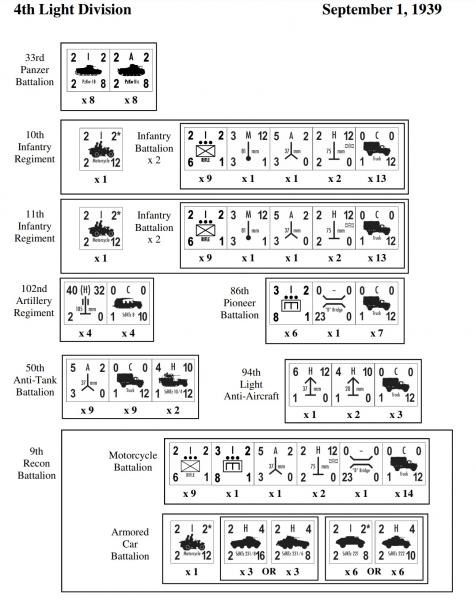 August 16, 2019 at 9:20 pm #1427150
August 16, 2019 at 9:20 pm #1427150
Okay, so brass tacks time …
@yavasa – for our game tomorrow I’m looking at Warsaw Armored Motorized Brigade’s (reinforced) attack against northwest Tomaszow. I’ll be sampling units from all across the Warsaw Armored Motorized Brigade (including the new attached tank battalions) but nowhere near full strength. Not only is this for historical accuracy, but also so the game doesn’t grow too large. 😀
I don’t really want to get into Sandomierz group for this game … from what I read Sandomierz was more or less the rear guard. We could include them, that that more than doubles the length of the board (x2 length, x 2 width = x4 area, extending much further to the northeast = x4 or more the units on both sides). Doable in the scale of Panzer Leader, but would be a large team game or 10-hour 1 vs. 1 game.
The Germans will have a sampling of units from the 4th Light Division. Again, keeping the game size under control … and also 4th Light Division was deployed in a holding arc more or less extending from north, around the west, and then the south of Tomaszow. So on our particular battlefield, the whole division certainly wouldn’t be deployed.
REPLIES:
@torros – Good call on the Battle of Mokra. I know you know this, but for others in the thread: the 4th Panzer Division to which @torros refers is not the same as the 4th Light Division I’m using at Tomaszow. 4th Panzer Division is just that … a full scale panzer division, easily twice as big as three times as powerful (at east in terms of armored strength).
Polish cavalry vs. German “tanks” – yes, this is a myth, one @yavasa and I have unfortunately perpetuated when he close assaulted some of my PzKpfw IIs with cavalry and actually destroyed one platoon! Okay, he was attacking our of urban cover, he had about 200 infantry helping him as well as antitank guns …
On a more serious note, to my understanding Polish cavalry did in fact see action against German armor – i.e. a panzeraufsklarungs abteilung (armored recon element – armored cars, basically, including the VERY light Kfz 13). Lances and sabers were not used. Something about the Germans lingering near a treeline from which the cavalry erupted?
Just one of those things where history gets oversimplified by careless inattention to detail and using the wrong terms. “Armor” does not always mean “tanks” – “cavalry” does not always mean “lances and sabers.”
@skiptotheend – Thanks! This is the false Polish attack and radio broadcast we’re talking about?
@yavasa – great look at the game Bzura! Man, thjos operational games are great. They have that one great weakness, though … the game usually only applies to one battle. The overall system can be applied over and over (as I was going to do with World War 2.5) – but even then you need new maps, new counter sets, etc. That reminds me, I have to start setting up that “Poland Defiant” game.
@jamesevans140 – Great point on the Condor Legion. That’s something I didn’t think of and have not yet covered. 😀
However the Pole are tough fighters for the motherland. I agree with what you’re saying about the Poles. Maybe this is just a different approach, or preference in wargames, etc. I try to stick to numbers, provable measures, and other factors when designing units, games, scenarios, or counters. Yes, German rifle platoons are “stronger” than Polish rifle platoons in my Panzer Leader scenarios, but this isn’t a comment on Polish commitment (I subtitled the thread: 80 Years of Defiance). It’s just:
German platoons in 1939, according to my records, show three platoons of four squads each. Polish platoons have three platoons of three squads each, although these Polish squads are admittedly larger (11 men + squadleader)
German platoons have the MG-34 and 5 cm Granatwerfer 36. The Poles do not. Brens and Vickers don’t cut it. For the record, British, French and American platoons have the same problem (usually a 2 attack factor instead of a 3, and Defense of 6 instead of the German 8).
The Poles have the Mortar M 36 (4.6 cm), but as we see below, there is only 2-3 per company, and they are assigned at the company level, not the platoon level.
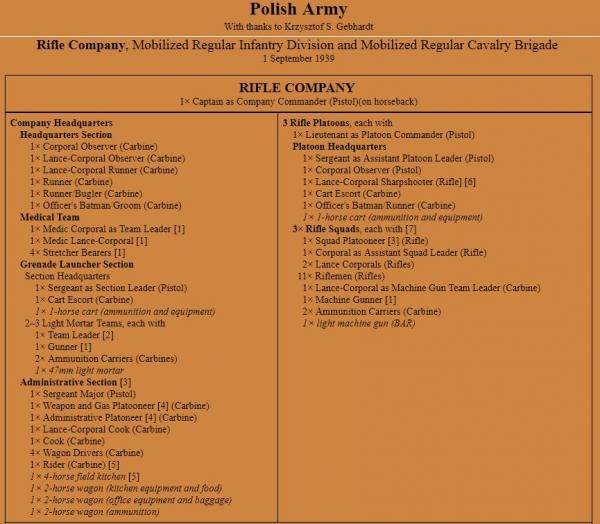
Regarding “toughness” where we can get a little subjective is in the “morale” system imported from Arab-Israeli Wars into Panzer Leader. I’m giving the Germans never higher than a B, sometimes a C. A is great and all, but that’s reserved for tough EXPERIENCED units and none of these German units I’m using so far are really “experienced” down to the rank and file in 1939. The Poles are the same. Well-trained, just not that experienced. So they’re getting the same B and C.
The point I raised is that it was not the push over history now tells us and I am sure you agree. – Absolutely, especially on the tactical level.
In the computer hex games playing the German most of my losses were infantry vs infantry battles. – I could totally see that. I had no indirect artillery fire available in my first game with @yavasa and man … getting Polish infantry out of town hexes was proving an uphill (and bloody) battle. This was done to simplify the game for a first-time player, but even in “campaign narrative” makes sense as many German units were savagely bloodied when they advanced too quickly and outdistanced their artillery (often horse-drawn) – then ran into a serious firefight with no artillery support ready on hand (outside of their infantry guns and mortars, of course, always the “secret sauce” of what really makes a German army work, I feel).
Tank ranges: The 500-800 meter range band for early war 2.0 and 3.7cm weapons you mention is totally reasonable, and I would agree 100%. That would be a range of 3-6 in my tweaked versions of Panzer Leader.
The reasons those ranges are not used …
Well, first off, those ranges are used for 2.0cm weapons (range of 4). These are usually autocannon that can “walk” onto a target.
For the 3.7cm with a range of 2, these seems counterintuitive. The thing is, this game is platoon / batter based. Every roll of the dice is a platoon of tanks shooting at another platoon of tanks for a given period of time. We’ve talked about this before, but it all cooks down to averages. At what range would 50% of 3.7 cm shells hit 50% of the targets 50% and stand a chance of penetrating 50% of the time? That range goes way down, to the 200-300m range (conservatively).
Again, the 2.0cm seems to have the edge here, with a range of 4. Well, it’s a lot easier for a platoon / battery shooting at another platoon / battery when that weapon is automatic. Also, the weapon CLASS is usually H, which means high explosive. This usually represents the weapon spraying at infantry targets, trucks, buildings, artillery emplacements, etc … where accuracy is less of a problem, much less armor.
Great question, I get asked it a lot because the values on the counters do seem a little screwy.
August 16, 2019 at 9:33 pm #1427155Warsaw Armored Motorized Brigade was a bit different than the 10th Motorized Cavalry Brigade because both the 1st Mounted and 1st Foot Rifles Regiments had an additional recce companies (platoon of motorcycles, platoon of bicycles, platoon of TKS tankettes each). All in all the Warsaw Armored Motorized Brigade:
- 1st Mounted Rifle Regiment (1. Pulk Strzelcow Konnych – 1. PSK)
- 1st Foot Rifle Regiment (1. Pulk Strzelcow Pieszych – 1. PSP)
Both included a platoon of enginners, platoon of HMG’s and anti tank platoon.
- 11th Recce Tank Company (13 x TKS tankettes, 4 of them with 20mm guns)
- 12 Light Tank Company (3x Platoons of Vickers tanks (5 each) plus the command tank)
- Brigade Reconnaissance Bn. had 13 x TKS tankettes, 2 of them with 20mm guns
- Two transport columns
- 2nd Motorized Artillery Bn (4 x 75mm guns and 4x 100mm guns)
- Anti tank battalion (2x companies = 36 AT guns don’t know the gun types
The units that joined later are a mystery so to say when it comes to the amount of tanks but according to major Stefan Majewski who was the former commander of the 11th Armored Bn. both the 11th Armored Bn and the 62nd Reece Tanks Company (which included scraps from the 61st Reece Tanks Company) were comparable to a platoon of tanks and this can suggest that more or less we can find 6 tanks in each unit. 2nd Light Tanks Battalion had 22x 7TP tanks. The 33rd Armored Battalion had probably 4 tanks on the 18th of September plus some armored cars.
August 16, 2019 at 9:41 pm #1427156@oriskany sure thing for tomorrow’s game when it comes to the size and units involved. I am all in, but would like to talk a few things earlier if that’s okay with you.
When it comes to cavalry vs tanks. There were instances when Polish cavalry clashed with German tanks but these were never charges. Cavalry units that took up a fight against German armor were either in defensive positions or the tanks run into the cavalry unit while it was in march, charging infantry etc.
As for the operational level games, yeah we have a history of these kind of games over here. I don’t know a Polish game on a tactical/squad level. So from my early years I played operational ones and things like Panzer Leader are new to me 🙂 Did buy ASL Starter Kit #1 this month. Would like to get Panzer Leader or Panzer Blitz but it is out of my reach.
August 16, 2019 at 9:48 pm #1427157These maybe of some use
Polish Infantry
http://usacac.army.mil/cac2/CGSC/CARL/nafziger/939PXPA.pdf
Polish Cavalry
http://usacac.army.mil/cac2/CGSC/CARL/nafziger/939PXPB.pdf
Polish armour
-
AuthorPosts
You must be logged in to reply to this topic.





























